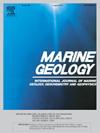纳米比亚中南部可容纳大陆架上(中新世至全新世)复合砾石矿床的成因与保存
IF 2.2
3区 地球科学
Q2 GEOSCIENCES, MULTIDISCIPLINARY
引用次数: 0
摘要
自晚渐新世以来,霍屯都茨湾纳米比亚陆架的砾石堆积在连续海侵中发育。利用超过12000线公里的地震数据和6000个钻孔,绘制了砾石矿床所在的古陆面(H1)。这是一个风化的基岩表面,上面覆盖着腐岩或粘土,覆盖着始新世的砂岩。尽管泥沙输入量很大,但隆起大陆架上有限的可容纳空间意味着松散的泥沙只在这个古陆表面的局部洼地和地形遮蔽带中积累。上覆松散沉积物由4个地震和岩石地层单元组成,其中最底下的砾石单元C和D为晚渐新世至晚上新世/更新世多期沉积。这些沉积物局部积聚在废弃的河流山谷和基岩承载的海湾中,为多层砾石海滩提供了优越的住宿条件。它们最初形成于小潮道的低洼滩,经淤积发展为厚滩。到了全新世,海湾的容纳空间被填满,多余的物质溢出到一个古海峡中,形成了线性的砾石海滩和砾石吐槽,由一个向陆的基岩高地锚定。它们通过在MWP-1B期间海平面快速上升期间的越位保存下来。在超过2000万年的多次海侵中,每个包都得以保存,而在其间的海平面占据期间没有进行重大改造,这归因于以下因素:(i)与大量砾石沉积相关的惯性;(ii)连续的砾石海岸线的快速掩埋;(iii)持续的高沉积物供应(包括海侵和沿岸);(4)避风环境下的优先沉积。砾石岸线在同一位置的多次重现反映了地质约束条件下沉积条件的持续性;在其他地方,海岸沉积物没有在海侵中幸存下来。最新的(全新世)沉积阶段与海平面缓慢停滞相吻合,在此期间,一个吐槽沿海岸推进。随后海平面的快速上升阻止了它的破裂和/或翻滚,并使它搁浅在大陆架上,成为一个独立的古海岸线特征。在多次海平面旋回中,任何更新世前体都被波浪冲刷破坏。本文章由计算机程序翻译,如有差异,请以英文原文为准。
Genesis and preservation of composite (Miocene to Holocene) gravel deposits on the accommodation-limited continental shelf of south-central Namibia
Gravel accumulations on the Namibian shelf off Hottentots Bay have developed during successive transgressions since the Late Oligocene. Using more than 12,000 line km of seismic data coupled with >6000 boreholes, the palaeo-land surface (H1) on which the gravel deposits occur was mapped. This is a weathered bedrock surface overlain by saprolite or clay and mantled by Eocene-age sandstones. Despite high sediment input, the limited accommodation space on the uplifted shelf means that unconsolidated sediment has accumulated only in localized depressions and topographically sheltered zones on this palaeo-land surface. The overlying unconsolidated sediment consists of four seismic and lithostratigraphic units (C![]() F), including lowermost gravel Units C and D that were deposited in multiple phases from late Oligocene to late Pliocene/Pleistocene. These accumulated locally in relict fluvial valleys and in a bedrock-hosted embayment that provided preferential accommodation for multi-stacked gravel beaches. They formed initially as lowstand lags in small tidal channels and developed into thick embayed beaches through aggradation. By the Holocene, accommodation in the embayment was filled and excess material spilled into a palaeo-strait, forming linear gravel beaches and a gravel spit anchored by a landward bedrock high. These were preserved through overstepping during rapid sea level rise during MWP-1B.
F), including lowermost gravel Units C and D that were deposited in multiple phases from late Oligocene to late Pliocene/Pleistocene. These accumulated locally in relict fluvial valleys and in a bedrock-hosted embayment that provided preferential accommodation for multi-stacked gravel beaches. They formed initially as lowstand lags in small tidal channels and developed into thick embayed beaches through aggradation. By the Holocene, accommodation in the embayment was filled and excess material spilled into a palaeo-strait, forming linear gravel beaches and a gravel spit anchored by a landward bedrock high. These were preserved through overstepping during rapid sea level rise during MWP-1B.
The preservation of each package during multiple transgressions over 20 million years without major reworking during intervening occupations of sea level is ascribed to a combination of:
- (i)inertia associated with voluminous gravel deposits;
- (ii)rapid burial by successive gravel shorelines;
- (iii)a consistently high sediment supply (both transgressive and alongshore); and
- (iv)preferential deposition in wave-sheltered settings.
The multiple recurrence of gravel shorelines in the same locations reflects the persistence of depositional conditions in geologically constrained settings; elsewhere shoreline deposits did not survive transgression. The latest (Holocene) phase of deposition coincided with a sea-level slowstand during which a spit prograded alongshore. Subsequent rapid sea-level rise prevented its breakdown and/or rollover and left it stranded on the shelf as a discrete palaeo-shoreline feature. Any Pleistocene precursors were destroyed via wave ravinement during multiple sea-level cycles.
求助全文
通过发布文献求助,成功后即可免费获取论文全文。
去求助
来源期刊

Marine Geology
地学-地球科学综合
CiteScore
6.10
自引率
6.90%
发文量
175
审稿时长
21.9 weeks
期刊介绍:
Marine Geology is the premier international journal on marine geological processes in the broadest sense. We seek papers that are comprehensive, interdisciplinary and synthetic that will be lasting contributions to the field. Although most papers are based on regional studies, they must demonstrate new findings of international significance. We accept papers on subjects as diverse as seafloor hydrothermal systems, beach dynamics, early diagenesis, microbiological studies in sediments, palaeoclimate studies and geophysical studies of the seabed. We encourage papers that address emerging new fields, for example the influence of anthropogenic processes on coastal/marine geology and coastal/marine geoarchaeology. We insist that the papers are concerned with the marine realm and that they deal with geology: with rocks, sediments, and physical and chemical processes affecting them. Papers should address scientific hypotheses: highly descriptive data compilations or papers that deal only with marine management and risk assessment should be submitted to other journals. Papers on laboratory or modelling studies must demonstrate direct relevance to marine processes or deposits. The primary criteria for acceptance of papers is that the science is of high quality, novel, significant, and of broad international interest.
 求助内容:
求助内容: 应助结果提醒方式:
应助结果提醒方式:


